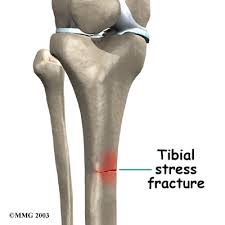Tibial Stress Fractures
This is an injury to the tibia (shin bone). The condition usually develops over a period of time resulting in a progressive overload to the muscle and bone.
What is this?
This is an injury to the tibia (shin bone). The condition usually develops over a period of time resulting in a progressive overload to the muscle and bone.
Causes
There are a few factors that are thought to contribute to the development of stress fractures and these include:
- High levels of running especially on hard surfaces.
- Sudden change in training volumes
- Poor foot and ankle biomechanics
- Lower limb weakness
- High impact sports
- Poor bone density
- Dietary
- Hormonal
What Structures can be affected?
- Muscle Periosteum
- Tibia
- Pain and Symptoms
- Symptoms can include some or all of the following:
- Pain will usually be aggravated by exercise and slowly settle with rest.
- Localised tender area over the tibia at the site of the lesion.
- Can sometimes develop significant night pain.
Diagnosis
The diagnosis is usually made from the history and from clinical testing. Further investigations such as x-ray, MRI and ultrasound can be undertaken to confirm the diagnosis and to assess other structures. Bone scan or an MRI will be the most sensitive form of imaging to assess for a stress fracture.
Treatment
One of the main focuses of treatment involves trying to correct the predisposing factors that contributed to the stress fracture. Conservative management would usually involve the following:
Rest – A period of rest from aggravating activities is important to allow the area to settle. This may even involve a period of non-weight bearing on crutches until the pain settles.
Bracing – In severe cases the use of a splint can be helpful in controlling the symptoms and allowing the stress fracture to settle.
Address Biomechanics – If there is poor foot biomechanics i.e. over pronating feet then orthotics may be indicated to help unload the area both in the short term and long term.

